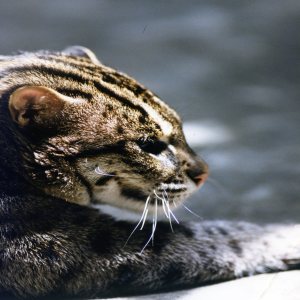Fishing Cat
[Prionailurus viverrinus]

The fishing cat has a deep-chested body and comparatively short legs. The front toes are partially webbed and the claws protrude slightly even when retracted because the claw sheaths are not fully developed. Only two other cats cannot fully retract their claws -- the cheetah and the flat-headed cat. Small rounded ears are set well back on the large, broad head. The short, coarse fur is grizzled gray or olive-brown and covered with small black spots. The markings sometimes run in longitudinal lines or rows. Large males may weigh 24 to 27 pounds while females are 13 to 15.5 pounds. Head and body length is 25.5 to 34 inches. The thick, muscular tail is less than 1/3 this length.
Fishing cats have been seen crouching on rocks and sandbanks, using their paw to scoop out fish. They've also been observed to seize fish with their mouths. Fishing cats have a median life expectancy of 5 to 10 years.
Location: The Upper RainForest
Share:
Range
The range of the fishing cat is India, Sri Lanka, southern Himalayas, Bangladesh, Vietnam, Thailand, Burma, China, Sumatra and Java.
Habitat
Fishing cats are found in areas of thick cover near water, in marshes, mangroves and densely vegetated areas and along rivers and streams.
Conservation Status
VulnerablePrimary Threats
Human Wildlife Coexistence, Climate ChangeGestation
The gestation period in fishing cats is 63 to 68 days.
Litter
Fishing cats can have 1-4 kittens in a litter.
Behavior
Nothing is known about the fishing cats social system, though it is believed they're solitary. Reports from zoos indicate that they're usually tolerant of one another so that several adults can be kept in the same enclosure. Fishing cats have been seen crouching on rocks and sandbanks, using their paw to scoop out fish. They've also been observed to seize fish with their mouths.
Reproduction
The young fishing cat suckle until they're about 6 months old and by 8.5 months they are adult sized. Kittens have been seen in the wild in April and June. Eyes open by 16 days and first meat is eaten at 53 days.
Wild Diet
Fish, crustaceans, mollusks, frogs, birds, small mammals, snakes, snails
Zoo Diet
The zoo diet includes Canine diet, bones once a week, and fish as available.

